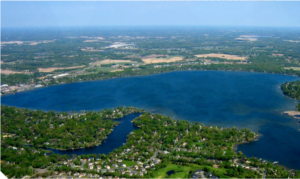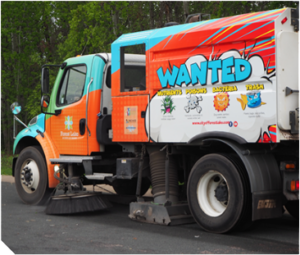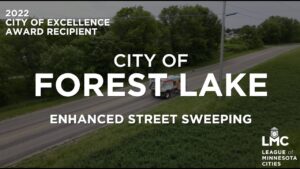Forest Lake Teams With Watershed Districts to Protect Local Water
By Andrew Tellijohn
For years, stormwater runoff in Forest Lake has drained into five lakes — two of which are now impaired with visibility issues. But the city, in conjunction with two watershed districts, has implemented at least a partial solution.

As part of a recommendation from the Comfort Lake-Forest Lake Watershed District (CLFLWD), the city implemented an enhanced street sweeping program that has greatly reduced the phosphorous runoff to the five lakes. The runoff reduction has significantly increased visibility into the water. It’s also likely to increase the shelf life of the city’s street infrastructure. The city received a League of Minnesota Cities 2022 City of Excellence Award for the initiative.
“Anything the city could do to reduce salt, sand, dirt, anything off the streets going into the lakes, was an important step to take,” says Forest Lake City Administrator Patrick Casey. “Cleaner streets mean people aren’t getting dirty cars, they aren’t blowing up dust. It makes it easy for us to see the condition of the road.”
A new approach
Mike Kinney, administrator with the CLFLWD, approached Forest Lake in 2014 about enhanced street sweeping. He knew that the area’s lakes needed more attention, but also realized any solutions had to be economically sound.
At the time, the city was contracting with a private contractor who performed the work once in the spring and once in the fall.
“In many locations, [city officials] spend thousands of dollars for each pound of reduced phosphorous,” he says. “That’s too high a number when you are using the same pool of tax dollars as library, police, street repairs, and schools.”
In 2017, CLFLWD, the Rice Creek Watershed District, and Forest Lake collaborated to apply for and receive a Clean Water Grant from the Minnesota Board of Water and Soil Resources to study and implement a plan for reducing the phosphorous load in the lakes.
A year later, they received the funds to add a staff position and purchase a regenerative air vacuum sweeper that would bring the street cleaning program in house.

The regenerative air sweeper removes three times more phosphorous than a traditional mechanical broom sweeper. Between the vehicle and the increased frequency of sweeping in targeted areas, the city reduced its phosphorous runoff by 309 pounds — which is significant since each pound of phosphorous that gets in the lake can produce 500 pounds of algae in the water.
“When we started seeing the number of pounds we recovered off the streets with enhanced street sweeping, we realized there is quite a bit of debris on the street you don’t see or that has accumulated in between those months between spring and fall,” says Public Works Director Dave Adams.
Plus bringing street sweeping in house was cost neutral for the city.
“When we talked with the watershed district and looked into this grant program, it became apparent that if the grant was awarded to us, we could do the entire spring, fall, and enhanced street sweeping with the money we were paying out [in contract services],” Adams says.
Kinney hopes to see the city start using the sweeper periodically through the winter months to recapture some of the road salt that eventually seeps into the lakes.
“It’s that enhanced part where it’s more than a couple sweeps in the spring and a couple in the fall that really makes a difference,” he says, adding that removing particulates from roads more frequently can extend their lifespan.
Adams says because of the documented success of the street sweeping, city staff are likely to go back for another Clean Water Fund Grant to add another sweeper. Kinney also would like to work with the city and the Forest Lake Lake Association to educate citizens to reduce the amount of grass and fertilizer blown onto streets by mowers.
“It’s important to have great partnerships like this,” he says. “Sometimes you do some work and you don’t get the outcome you wanted. We got really great return on investment and now we’re seeing not only this being rolled out in Minnesota, but we anticipate this being expanded to other states.”
Collaboration is key
City staff agrees the results were driven by the collaboration.
“The watershed was a great driver for this entire grant process, and filling out the application necessary and coming up with the numbers for total phosphorous reduction,” Adams says. “You need that technical expertise from a watershed to make that grant complete.”
Much of the work was underway by the time Casey arrived as Forest Lake’s city administrator in 2018. But he quickly understood the importance of the city’s lakes and stressed the importance of the collaboration between the city and the watershed districts in getting these plans off the ground.
Forest Lake, he says, is working with Washington County on a new environmental center and yard waste drop-off site and with the county’s economic- development authority for grants. The city has always worked with the school district to have a police presence in schools or at other community activities.
“It’s important, especially these days when things are expensive, to try to partner with whoever you can, whether it’s a lake district, a school district, a local county,” he says. “That’s one thing I have stressed since I have been here is to partner with those surrounding municipalities or governments or agencies to do a better job and to try to enhance our services without too much more of a cost.”
Pleased with the efforts
While Forest Lake may never have the same water quality that a city in northern Minnesota might, the street sweeping and other efforts by the city and watershed district are appreciated and are having a significant impact, says Jerry Grundtner, president of the Forest Lake Lake Association.
“It’s a great tool,” he says. “Some other cities are starting to look at this as an option. It’s cool that Forest Lake is on the cutting edge of something that may help other lakes across the state.”
He praised the Watershed District for a 2019 $1 million-plus cleanup effort that helped reduce phosphorous run-off into Forest Lake from Shields Lake. That project, the street sweeping, and other efforts have helped increase visibility into the water from two to three feet to between six and nine feet at certain times now.
“The quality of Forest Lake has gotten better over the last few years,” he says. “We still have a ways to go. There are around 1,000 homes around Forest Lake. Everybody has yards and fertilizer that goes into the lake from the yard. There is a lot of pressure on the lake. The efforts of the street sweeper and the other projects have really helped.”
Andrew Tellijohn is a freelance writer.


